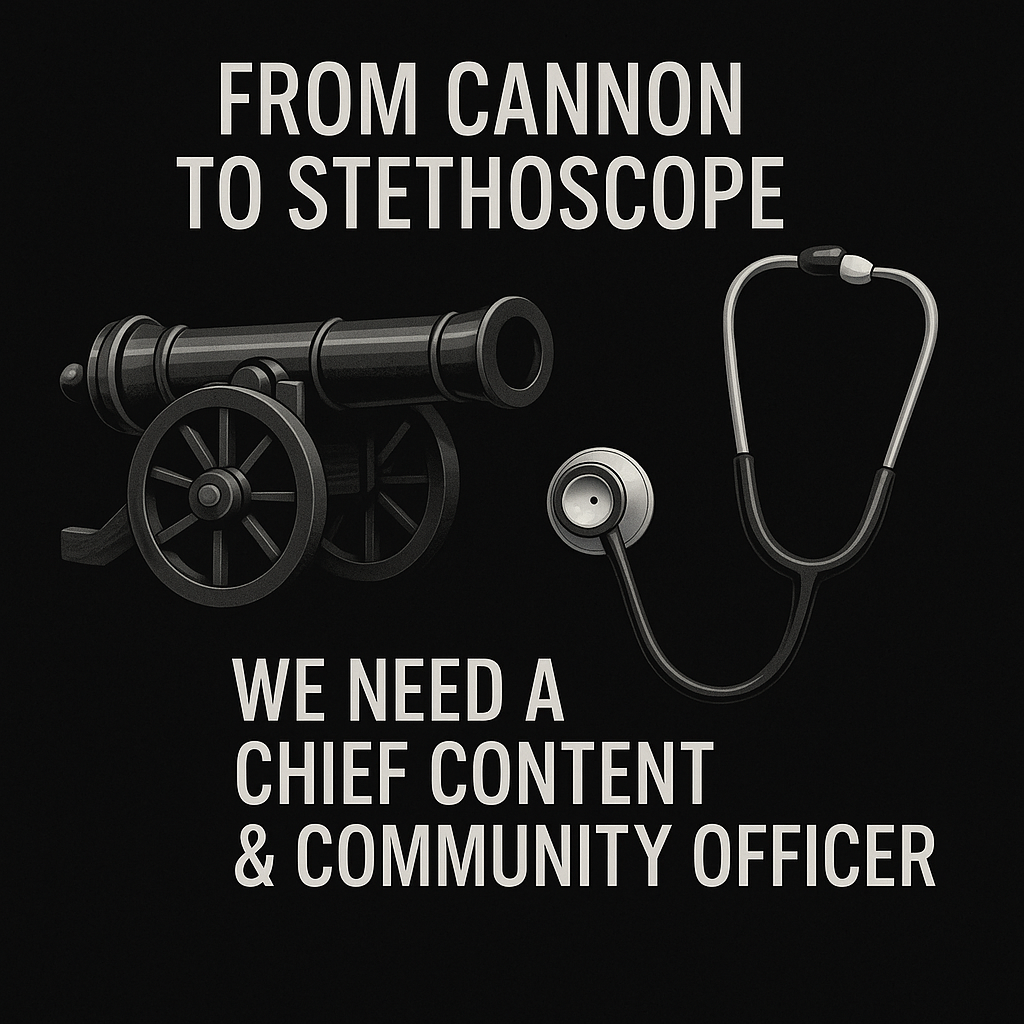From Cannon to Stethoscope: We Need a Chief Content & Community Officer
Content with a view - media marketing & AI
There was a time when the TV spot was the magic wand of marketing. The 30-second ad was king: all resources allocated to it, marketing reduced (wrongly) to pure advertising. You placed your king on TV with the right pressure, and the game was done.
Today, the spot still exists. Big brands still use it as a reassuring paradigm. But the provocative — and necessary — question is: do we really still need it? And above all, what is a spot today?
According to the Journal of Advertising Research, today it takes 25% more pressure to achieve the same effect as before. Understandable: fragmentation of channels, scattered attention, duplication. To open a tuna can, you now need a bazooka. More budget, less impact. And the off-record answer I hear most often is always the same: “I plan the first two or three big players and get it off my plate.”
Where the audience has gone
In Italy, over 60% of video consumption among younger generations (18–34)already happens on digital platforms(YouTube, social, and streaming), versus less than 40% on traditional TV (source: Comscore 2024).
YouTube alone reaches 42 million Italians each month, more than any traditional broadcaster (source: Google).
AGCOM confirms the structural growth of digital: 36.5 million users on free VOD services and 15.9 million on paid ones (2024).
Linear TV still has a place, especially for live events: sports, big shows, the moments of “everyone together in front of the screen.” And here, the usual recipe kicks in: a Sanremo spot, four stories with a creator, and done. Does it work? Maybe. But that’s not the point.
The real issue: how attention works
Traditional spots guarantee control: brand safety, intact message, zero risk. But the attention they capture is increasingly distracted.
And using creators “the old way” — a couple of funny stories and a quick promo — doesn’t move the needle much.
The data speaks clearly:
Creators generate up to 80% brand recall vs. 40% for traditional ads (Nielsen).
Influencer marketing delivers an average ROI of 5.2:1 (vs. 1.2 for traditional TV in the UK, Ebiquity).
70% of Gen Z purchase decisions are influenced by communities and creators (Deloitte).
These aren’t “cute report stats”: they signal a radical democratization of audience choices. The brand is no longer monolithic, carved in stone. It is dynamic, evolving with culture, needs, and real conversations.
The brand is built by those who use it
This applies to everyone, not just giants. Whether you sell cookies or IT solutions, today the brand is shaped by those who use it, not those who make it.
You have to listen: understand real needs, concrete problems, perceptions in the customer’s mind.
In the age of intermediation, it was easier: someone told you what to think — TV, multinationals, certified experts. Not anymore. That doesn’t mean bending to every whim of the audience. It means purchase reasons have changed and no longer align with the polished, perfect message.
Brands in crisis, brands that listen
Legacy brands are struggling. Nike is a clear example.
Who survives? Those who have understood that building brand culture is essential. Not flash sales through performance marketing, but exponential and lasting value.
Look at streaming: Netflix succeeded by creating an almost religious cultural bond, speaking directly to its audience, constantly changing its approach.
I also covered this in my podcast:
With Chiara Grillo of Unilever, who explained how democratizing storytelling — combined with AI — changed the fate of a historic brand like Algida.
With WeRoad, which doesn’t sell trips but excitement and experiences, letting customers themselves build the brand.
A new role is needed
This is why we now need a Chief Content & Community Officer.
Not a superhero, but someone who knows how to:
bring together spots, creators, streaming, and communities,
use the stethoscope more than the cannon,
listen, understand, orchestrate.
TV isn’t dead, of course. But it can no longer be the sole village square.
Brands that want to grow must accept a simple reality: they no longer decide alone who they are. Their community decides too.


